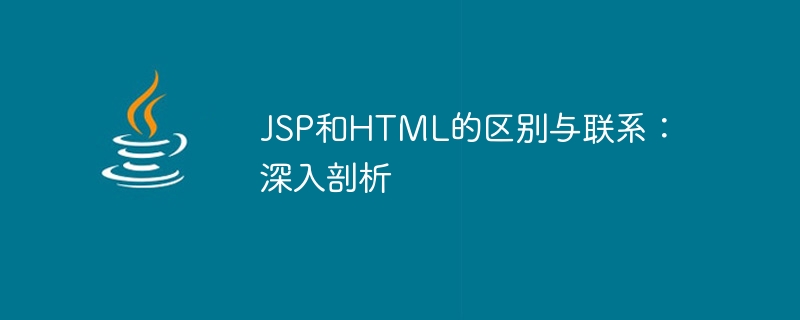Home >Java >javaTutorial >Explore the similarities and differences between JSP and HTML: comprehensive analysis
Explore the similarities and differences between JSP and HTML: comprehensive analysis
- 王林Original
- 2024-02-01 09:44:051038browse

The difference between JSP and HTML
- ##Difference in syntax: JSP uses Java syntax, while HTML uses HTML grammar.
- Different functions: JSP is a server-side scripting language, while HTML is a client-side markup language. JSP can perform complex business logic, while HTML can only be used to describe the appearance of a web page.
- Different scopes: The scope of JSP is the server side, while the scope of HTML is the client side. JSP can generate dynamic content on the server side, while HTML can only display static content on the client side.
- Different security: JSP is an interpreted language, so there are certain security risks. HTML is a compiled language and therefore more secure.
- Different performance: The performance of JSP is lower than that of HTML because JSP needs to be executed on the server side. HTML has higher performance than JSP because HTML does not need to be executed on the server side.
The connection between JSP and HTML
- JSP can contain HTML code: JSP is a server-side scripting language. Therefore it can contain HTML code. This allows JSP to be used to generate dynamic HTML pages.
- JSP can generate HTML code: JSP is a server-side scripting language, so it can generate HTML code. This allows JSP to be used to create static HTML pages.
- Both JSP and HTML can be used to create Web pages: Both JSP and HTML can be used to create Web pages. JSP can be used to create dynamic Web pages, while HTML can be used to create static Web pages.
The advantages and disadvantages of JSP and HTML
The advantages of JSP
- Powerful functions : JSP can perform complex business logic, so it can be used to create powerful web applications.
- Strong flexibility: JSP can be integrated with other Java technologies, so it can be used to create various types of Web applications.
- High security: JSP is a compiled language, so it is more secure.
Disadvantages of JSP
- Low performance: The performance of JSP is lower than HTML because JSP needs to be executed on the server side .
- steep learning curve: JSP is a complex language, so the learning curve is steep.
- High development cost: The development cost of JSP is higher than that of HTML because JSP requires more developers and development time.
Advantages of HTML
- High performance: The performance of HTML is higher than JSP because HTML does not need to be on the server side implement.
- Flat learning curve: HTML is a simple language, so the learning curve is gentle.
- Low development cost: HTML development costs are lower than JSP because HTML requires fewer developers and development time.
Disadvantages of HTML
- Limited functionality: HTML can only be used to describe the appearance of a web page, so it cannot execute Complex business logic.
- Poor flexibility: HTML cannot be integrated with other technologies, so it can only be used to create simple web applications.
- Low security: HTML is an interpreted language, so it is less secure.
Conclusion
JSP and HTML are both common technologies for creating Web pages. JSP is a server-side scripting language, while HTML is a client-side markup language. JSP can perform complex business logic, while HTML can only be used to describe the appearance of a web page. The scope of JSP is the server side, while the scope of HTML is the client side. JSP has lower performance than HTML, while HTML has higher performance than JSP. JSP is more secure than HTML, while HTML is less secure than JSP. JSP can contain HTML code or generate HTML code. Both JSP and HTML can be used to create web pages. The advantages of JSP are powerful functions, strong flexibility, and high security. The disadvantages of JSP are low performance, steep learning curve, and high development cost. The advantages of HTML are high performance, gentle learning curve, and low development cost. The disadvantages of HTML are limited functionality, poor flexibility, and low security.The above is the detailed content of Explore the similarities and differences between JSP and HTML: comprehensive analysis. For more information, please follow other related articles on the PHP Chinese website!
Statement:
The content of this article is voluntarily contributed by netizens, and the copyright belongs to the original author. This site does not assume corresponding legal responsibility. If you find any content suspected of plagiarism or infringement, please contact admin@php.cn

